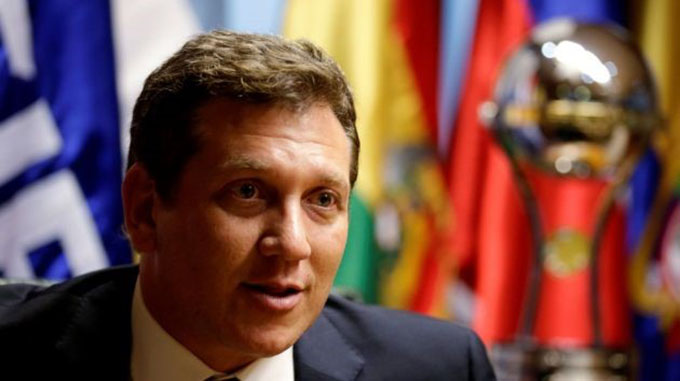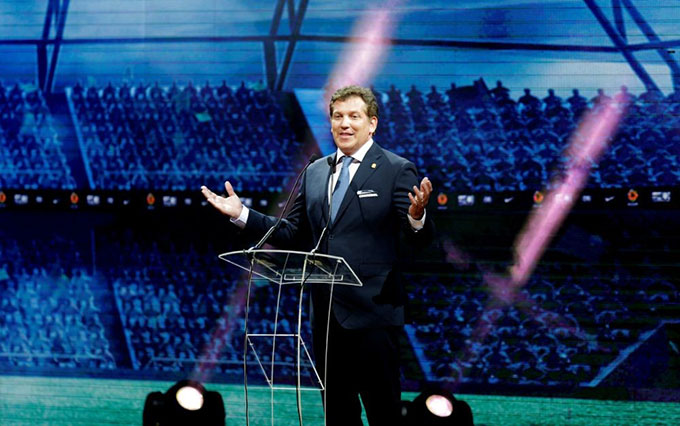Search the latest and greatest job opportunities in sport

Paraguay’s Alejandro Dominguez stepped into one of the most tarnished roles in world soccer when he became president of South American confederation Conmebol in January 2016. His three immediate predecessors - Juan Ángel Napout, Eugenio Figueredo and Nicolás Leoz - were all implicated in corruption scandals with the former two being arrested, and Leoz placed under house arrest.
For Dominguez, turning around the images and practices of Conmebol - and preaching better methods to its ten member associations - is only one priority for modernisation. At club and international level, there is a need to properly harness the passion and potential of South American soccer in an era of globalisation - working with neighbours to the north in some cases, and delivering local updates in others.
With all that in mind, SportsPro caught up with Dominguez for a short interview at the Football Talks conference in Estoril, Portugal.
SP: How have you tried to establish yourself in this role and take the organisation away from what had gone before?
AD: I saw the opportunity. I didn’t see the crisis. I saw the opportunity and I’m working with my team to transform Conmebol from a 19th century organisation to a 21st century organisation. So we’re moving forward in that direction and the big task that we have is to refocus the organisation to have football as an end – and the means would be the money. I’m saying this because when I got here I understood that this was managed like a personal business and that the end was money and the means was football.
It seems easy but it takes time, because changes, always, are not as smooth as you or I would want it to be.
What are some of the tangible steps that you’ve taken or are looking to take in order to do that?
Well, if you see the budget, first thing’s first, the budget is public. Now anyone – all of us, whoever – they can know how much money gets into Conmebol and how much money comes out of Conmebol. Not only can they know how much goes out, but where it goes.
Why do I say this? Because before I got there, the amount of money that was given to the clubs for playing the Copa Libertadores was no more than US$40 million. And now we’re giving to the clubs, for the three cups - the Libertadores, Sudamericana and the Recopa - US$139 million. So that is putting the money where you want to, which is where it always had to be given.
So we’re pushing forward, and all the changes we’re doing are because we understood there was a problem, and we understood that the performance of our teams wouldn’t be as we wanted if we didn’t change the skills and the programmes and all the things we did for football and for the good of the game. I truly believe that after having done that, now that we’re going to go to an open process and open bidding, more money will come into the organisation, so more money will go to the clubs. Therefore, more money should get to the players.
That’s why we also launched the club licensing – so that we can be sure that, when that happens, there will be fair play.

This was something that was put to your colleague at Concacaf, Victor Montagliani , as well. It’s not just officials that have been brought down in the last couple of years but partners and intermediaries. Now that more companies are coming in to fill that space, how do you make sure you aren’t replacing one set of dubious associates with another?
I understand and I would say that is a very good question, and it’s a challenge. I truly believe in my people, that we are moving forward doing the right things, and I believe that the way we are going to present it will be open and will be transparent. And we are asking that the final customers will come and buy the rights of Conmebol.
I don’t like middlemen, and I’ve always been clear with that. So there are ways to do it. We’re not going to be the first ones to do it, so we’ve got to learn how other people did it the right way – and we’re going to do it the same way.
How much has got to come from individual member associations, and clubs, and leagues in South America to modernise and tighten up the way business is done through soccer?
Well, the transformation has to be from top to bottom and bottom to top. We’re doing it. We’re moving forward for the association members and the clubs, but they also have to do their side of the work which is, as I mention, put numbers, pay the right amount to the players, invest in the grassroots, in developing football – no matter whether it is in futsal, beach soccer, no genders, all genders, it has to get there.
So far, we’ve been getting these players – both genders again – winning all around the world. I couldn’t imagine, if we nurtured them, how much more we’re going to get. That has to be done from our side and it has to reach to the teams, to the clubs, and they have to tell their side of the story.

How closely are you working with Concacaf on these things, across the two continents?
Well, I’m a close friend to Victor, as I am a close friend to Aleksandr [Čeferin, the Uefa president]. As I said in my speech, I’m here to try to work on integration. I truly believe that the ball makes us friends.
Even though we compete, we have to learn that, above competing, we are friends, and we have a high responsibility to show the world that the ball has to unite us. Everyone will still be who he is: we’re still Conmebol, there’s no way we’re going to get together with another. But that doesn’t mean that we can’t work together to promote and do more things for football.
There have been reports in the last few weeks about the US hosting Copa America in 2020.
The Copa America that we’ll be hosting is in Brazil in 2019. From then on we have an open table, with both sides working to see if it’s possible to have another Copa America in the United States, and see whether it’s always going to be played there or is it one time there, second time in South America. That’s undecided as yet.
What about the competition structure in South American club soccer? The Copa Sudamericana is being moved.
It’s being played together - the Copa Sudamericana and the Libertadores all together with the national teams playing their own tournaments. So we’re open, spreading the time, so they can get more time to play both.
What’s the challenge of doing something like that across a continent the size of South America, where you have so many domestic competitions – and state competitions, in countries like Brazil – that are so important to people?
The changes were done together with the member associations. We didn’t do it on our side. For the first time, we opened it, we brought everyone in, we told them our idea. They managed their own changes inside their tournaments and we’re OK with that.
Even though 2017 is a transitory year, we’re hoping to get together with the clubs and see what’s going on - what they think were the good things that were done and what has to be done next year to get better. So far, no bad reports.
What’s the commercial potential for South American club competitions?
I can only tell you what the floor is, and the floor is what we get today. I can’t tell you what the top number is we’re going to get.
This article was originally published by our partner, SportsPro Media from an article writtern by SportsPro's Eoin Connolly ( @eoinfconnolly ).
Give your career in sport a boost with the latest live vacancies , or create an account today and stay up to date with all the latest industry knowledge, events and jobs in sport.
Search the latest and greatest job opportunities in sport